Porcelain Insulator News
by Elton Gish
Reprinted from "Crown Jewels of the Wire", September 2000, page 3
Some of you have been collecting insulators for a few decades and may think
you are in the running for the person who has collected insulators the longest -
as limited to collectors in the U.S. We all know Keith Neal in England was
probably the first insulator collector in about 1915. N. R. "Woody"
Woodward was one of the first U. S. insulator collectors when he started
researching insulators back in the 1950's. However, one person recently
indicated to me that his family was perhaps the first to collect multipart
porcelain insulators in this country and he has a photograph to prove it.
Loren
Mills lives about 20 miles south of Portland, OR. The Mills family settled in the
Springbrook area of Newberg in 1888 when Loren's father was only four years old.
During the early part of this century, there was a railroad station, country
store, church, and fruit cannery about a mile from his family farm. The Mills
family was familiar with insulators. Loren stated, "I just referred back to
copies of the minutes of the Springbrook Telephone Company from 1906-1917. My
grandfather, Zimri Mills, was one of the presidents during that period. My
father, Dennis Mills, was the superintendent in charge of telephone line
installation and maintenance from about 1914 on. The company was sold to an
Independent company in 1917, and my father was instrumental in moving the lines
to their poles. I noted one item from the minutes of 1910 of interest -
"Knobs, wire, etc. - $5.50". Apparently my father helped maintain the
lines through the 1930's because I remember helping him as a youth on the farm
and using the climbers." Until about the mid-1930's, the local power company
was the Yamhill Electric Co. It was later taken over by Portland General
Electric with much of the power provided by the Bonneville Power Station on the
Columbia River.
Loren sent me two photographs of himself between two old
multipart insulators that were taken 75 years apart. The family used old
insulators around the yard all his life to hold water for birds and insects. The
first photograph was taken in about 1925 and shows Loren at about age one
between two M-4605's as if he is proudly showing off his infant collection. The second
photograph was taken recently and shows Loren all grown up between two M-3451
insulators made by the Ohio Brass Co. I doubt that any of us could come close to
claiming a more than 75-year history of collecting multipart porcelain
insulators. After all, most of us didn't know what they were just 15 years ago.
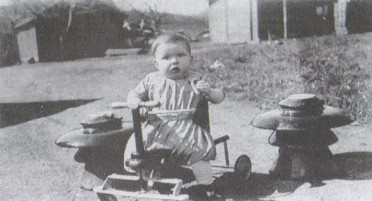
Loren Mills, age one, between two M-4605's.
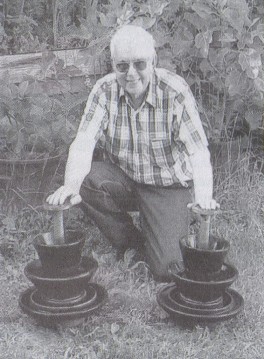
Loren Mills, mature age, between two O-B M-3451's.
In the March 1999 issue of CJ, we reported Bob Kay's white U-400B with two
under-glaze ink markings, "triangle M" and "Line Material",
and discussed the two styles of loop insulator and the association between Line
Material and triangle M marking used by Illinois Electric Porcelain Co. Earlier
this year, Tom Moulton (NIA #169) reported a chocolate brown U-400B with the
same two under-glaze ink markings and the number "694" which is the
catalog number for the style and color. Actually, the triangle M marking on
Tom's insulator was missing two sides of the triangle and only had the one line
under the "M". Then in the May 1999 issue we reported Stanley
Klein's
(NIA #5372) white U-399B with the same two markings and the number
"696". Stanley brought the insulator to the Bloomington National this
past July so I could see it. Below is a photograph showing the three under-glaze
ink markings on Stanley's insulator.

White U-399B with under-glaze ink markings for Line Material,
triangle M, and
the catalog number "696".
While on the subject of double markings, Tim SanSoucie (NIA #5129) showed me
at the Bloomington National a chocolate brown U-138. On the skirt is the usual
incuse Illinois map marking with "29" at the top of the map and"
119" inside the map. This indicates the insulator was made in 1929. The
number "119" is the catalog number. The second marking is just above
the wire groove. It is an incuse "triangle B" marking that I have not
seen before. If anyone has an idea what it could be, please let me know.
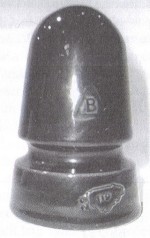
U-138 with incuse Illinois map
marking and the unusual
incuse "triangle
B" marking.
Stanley Klein had several interesting insulators in addition to the U-399B.
One that particularly caught my eye was a light blue U-241A made by Pittsburg.
It was unmarked but you might recognize it better if it had the uncommon incuse
marking "JOHNS-MANVILLE" on the dome. This is the only whole, unmarked
blue specimen that I have seen. Many years ago, Jerry Turner (NIA #72) found a
badly broken one at the Pittsburg dump. Bill Rohde (NIA #1219) has a broken blue
and broken white U-241A with the Johns-Manville marking that came from the
Pittsburg dump. I have a mint unmarked white U-241A that is the only one ever
reported. It is very likely that Pittsburg made the U-241A for Johns-Manville and
then decided to make a quantity of them unmarked in various glaze colors for
sale in their catalog. Several unmarked brown U-241A's are known, but most have
the Johns-Manville marking on the dome.
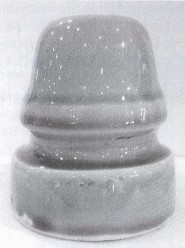
Unmarked U-241A with
light blue glaze.
We've reported from time to time unusual Fred Locke vintage insulators that
Ken Willick uncovers at the Victor dump or that he finds in his area near his
home in Lima, NY. At Bloomington, Ken had a badly damaged unmarked specimen of
the 3-part glazeweld style, U-954D, which he dug at the Victor dump. What makes
this specimen so unusual is it has a white glaze! All known insulators of this
style are unmarked and have a tan glaze color. Thanks to Jeff Hogan's keen
observations, we recently discovered that the drawing for U-954 represents the
more modem version that is a 2-part glazeweld. In fact, the U-Chart drawing for
U-954 was made from an illustration in the 1913 Locke catalog. Since all of the
older styles are 3-part glazewelds, and are taller with a somewhat flared lower skirt, it was decided to assign them a new number,
U-954D. In some cases, as with Jeff's two insulators, his U-954, with incuse
Victor R=oo logo marking, is 1/2" shorter than his U-954D. A variation of
1/4" is acceptable for all but the largest styles in the U-Chart. The
1/2" difference is due to Jeff's U-954 being shorter than typical and his
U-954D being taller than typical. Measurements from several specimens were taken
before making the drawing for U-954D.
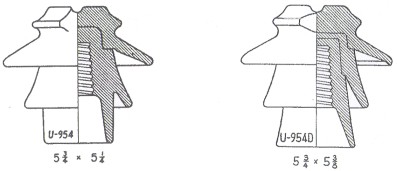
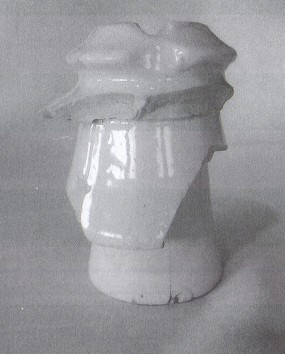
Specimen of a white U-954D dug at the Victor dump.
Another of Ken's great finds was not found at the dump. Many of us have
crudely-made dry process white egg-shaped strain insulators. I've seen many of
these and have two different sizes in my collection, but have you ever seen
one with a marking? Remember, these were made of dry process porcelain so the
marking cannot be incuse (struck into the surface). What makes Ken's insulator
so exciting is the unique marking. The marking is on one end just above the
center of the wire groove (or Pac Man mouth). The marking is EMBOSSED (not
incuse - precisely why it is important to NOT describe incuse markings as
"embossings" - save that nomenclature for glass) with the letters:
LIMA / N.Y. (this means "N.Y." is below the word "LIMA").
Since the Victor factory and the Lima factory only made wet process porcelain
insulators, Ken speculates that this insulator was made at the Akron High
Potential Porcelain Co. in Barberton, OH (suburb of Akron) during the time that
Fred Locke's son, Morton, was helping the company to produce insulators made of
wet process porcelain. As we know from my book, Fred M. Locke: A Biography,
Morton Locke was at the Akron factory from late 1905 until late 1906. Dry
process porcelain, while inferior to wet process porcelain, was cheaper to make and quite suitable for guy strain use. The Lima
Insulator Co. (1904-1908), with direct ties to Fred Locke and Morton Locke, very
likely had this strain insulator made at the Akron factory. You may want to
check your white egg-strain insulators for this "embossed" Lima
marking.
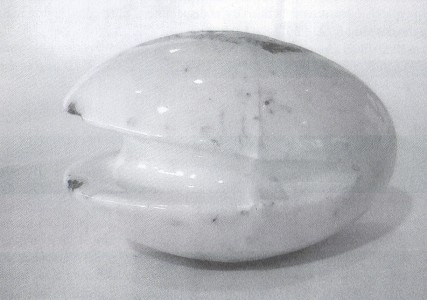
White glazed dry process egg-shaped guy strain insulator
with embossed
marking: LIMA / N.Y.
| 